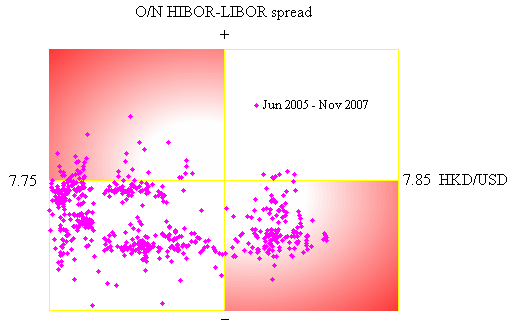Recent events have thrown up some anomalies in the relationship between local interest rates and the exchange rate.
Readers may be aware of the attention we have been paying to the relationship between interest rates and the exchange rate, or more precisely the level of Hong Kong-dollar interest rates relative to corresponding US-dollar interest rates and the exchange rate, within the Convertibility Zone defined by the two Convertibility Undertakings. To support interest-rate arbitrage, when the exchange rate is on the weak side of 7.80, there should be a premium of Hong Kong-dollar interest rates over those for the US dollar. Conversely, when the exchange rate is on the strong side of 7.80, there should be a discount of Hong Kong-dollar interest rates from those for the US dollar. But, in practice, this relationship does not always hold true. Fluctuating demand for interbank liquidity, against a fixed supply defined by the Aggregate Balance, often takes interest rates to levels beyond those suggested by the theoretical relationship without generating the self-correcting foreign-exchange transactions that the theory calls for. Readers may wish to study the attached chart, showing daily observations of the relationship between the interest-rate premium and the exchange rate within the Convertibility Zone since the introduction of the three refinements in May 2005.
According to the theory, one would expect most of the observations to be in the North-East and South-West quadrants. However, readers will notice that there are many observations in the North-West and South-East quadrants. Given that there are perceived risks in interest-rate and exchange-rate arbitrage, even with a fixed-exchange-rate system that is highly credible, and given that the benefits of arbitraging out small deviations from the theoretical relationship are limited, a degree of departure from that relationship is understandable and therefore tolerable.
But when the exchange rate is very near to the strong-side Convertibility Undertaking and there is a large interest-rate premium, this can be a cause for concern. This is because a further, small strengthening of the exchange rate could trigger the Convertibility Undertaking, and, given the large amount of transactions in the foreign-exchange market each day, a large amount of US dollars could be presented to us, resulting in a large increase in the Aggregate Balance and a sharp drop in interbank interest rates. While the direction of adjustment is not in doubt, the sharpness of the adjustment might be destabilising.
The same applies when the exchange rate approaches the weak-side Convertibility Undertaking at a time when demand-and-supply conditions in the interbank market are such that there is also an interest-rate discount. Hong Kong-dollar interest rates could move from a significant discount to a large premium within a short period, and this could have financial-stability implications.
In September and most of October, domestic interest rates in Hong Kong, particularly the short-term ones, were persistently above their US counterparts. This was due to a confluence of factors. First, the bunching of IPOs over an extended period led to continued strong demand for Hong Kong-dollar funds. Secondly, banks have become cautious in managing their interbank lending and borrowing after the sub-prime problems and tightened their credit-risk management. Thirdly, stock-market activities have increased substantially, and customer flows have become less predictable. This has led banks to become more conservative in liquidity management, holding balances at day-end that are larger than usual to meet the cash settlement for equities transactions early next morning. These factors have led to temporary spikes in the interest rates despite the strengthening of the Hong Kong dollar because of the strong equity-related inflows. These prompted the recent market operations by the HKMA and the injection of liquidity eased interest rates and moved the Hong Kong dollar away from the strong-side limit.
One may argue that there is scope for the HKMA to operate within the Convertibility Zone to smoothe out interest-rate movements by adjusting the Aggregate Balance to meet the shifting demand for liquidity. It may be that operations at the appropriate time can bring about more gradual adjustment and perhaps even pre-empt the Convertibility Undertaking from being hit. However, there is always the risk of our operations being misunderstood as not just smoothing things out but also as targeting interest rates. We will therefore need to consider these ideas carefully and ensure that whatever action we may take is strictly in accordance with the Currency Board rule that the Monetary Base must always be 100% backed by foreign exchange.
Against the background of ever-increasing turnover in the stock market and heavily over-subscribed new stocks, there is obviously a need to enhance the management of liquidity within the financial system. We will as usual encourage banks to strengthen their liquidity management and consider ways to recycle the IPO money back to the market quickly and efficiently. We are also working with the banking industry to introduce a new device to improve the efficiency of the cash settlement of stock trading. This will hopefully relieve banks of the need to sit on substantial funds for the settlement of equities transactions the following morning.

Joseph Yam
6 December 2007
Click here for previous articles in this column.
Document in Word format


